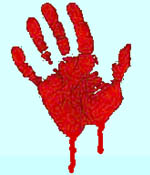
Death Penalty and Talmud Law | |||||||||||||||||||||||||||||||||||||||||
 In 1999, the US Supreme Court accepted a death penalty brief based wholly on Talmud law. The advocates say the Talmud has a better way. Does it?
 Rabbi Noson Gurary is the Executive Director of the Hasidic Chabad of Buffalo, New York. According to his bio, "he is teaching courses in the University at Buffalo and in the Law School, writes and publishes books in the area of Jewish misticism [sic] and Chassidic philosophy, conducts Lunch & Learn programs, personally runs Chabad House on Shabbos and Holidays, constantly councels [sic] on all levels." (3) As founder of the National Institute for Judaic Law, Rabbi Gurary is quoted by the Jerusalem Post: "By demonstrating the philosophy of Jewish law and its moral values, we can bring a little beacon of light to this world." (1) 
Israeli Supreme Court and the pedestrian bridge over Yitzhak Rabin Blvd. in Jerusalem. 
Pile of Dung 
Stripped to the Waist. Under Talmud law, a woman whose husband suspects her of infidelity but has no proof is subjected to a trial by ordeal. Before the trial she is stripped to the waist and put on public display. 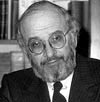 Nathan Lewin, in his brief to the US Supreme Court, echoes the words of Rabbi Justice Elon: "Jewish Law was particularly insistent on the preservation of even a criminal's rights and dignity during the course of punishment." 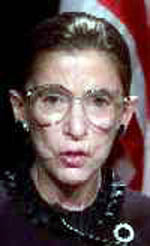 Supreme Court Justice Ruth Bader Ginsburg was nominated to the United States Court of Appeals for the District of Columbia Circuit by President Jimmy Carter and sworn in June 30,1980. She was nominated Associate Justice of the Supreme Court of the United States by President Bill Clinton and sworn in August 10, 1993. Along with Justices Scalia and Breyer, Justice Ginsburg attended the kosher dinner held at the Supreme Court building on November 5, 2002, to mark the founding of the Washington-based National Institute for Judaic Law.(1) Justice Ginsburg received the American Jewish Committee Award for Distinguished Jewish American and Israeli Feminists in January 2000 at a ceremony in the Israeli Knesset. See And So a Talmud Marriage Ends (40) 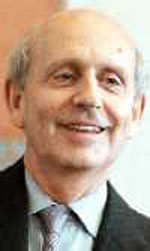
Supreme Court Justice Stephen G. Breyer was nominated Judge, United States Court of Appeals for the First Circuit by President Jimmy Carter, December 10, 1980 and held Chief Judge, 1990-1994. He was nominated Associate Justice of the Supreme Court of the United States by President Bill Clinton, and sworn in August 3, 1994. Along with Justices Ginsburg and Scalia, Justice Breyer attended the kosher dinner held at the Supreme Court building on November 5, 2002, to mark the founding if the Washington-based National Institute for Judaic Law.(1) 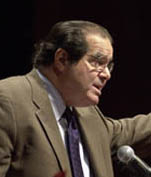
Justice Antonin Scalia was nominated to United States Court of Appeals for the District of Columbia Circuit by President Ronald Reagan and sworn in August 17, 1982. He was nominated Associate Justice of the Supreme Court of the United States by President Reagan and sworn in September 26, 1986. Along with Justices Ginsburg and Breyer, Justice Scalia attended the Kosher dinner held at the Supreme Court building on November 5, 2002, to mark the founding if the Washington-based National Institute for Judaic Law. According to the Jerusalem Post, "Scalia, in a letter to the institute's founder, Noson Gurary, wrote that 'Jewish law is certainly one of the oldest and most highly developed systems' and explained why the comparative study of legal traditions was beneficial."(1) 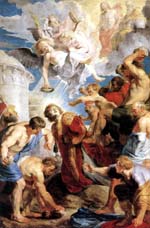 The Stoning of Stephen is described in Acts 7:57-60, and has been a popular subject for dramatic paintings and sculptures for hundreds of years. According to Acts, Stephen was condemned by a single priest and taken outside the city gates. There is no mention of platform or pit in the St. Stephen incident, nor in any of the other stoning incidents in the New Testament.(2) 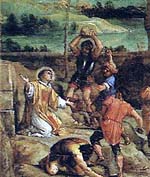 The Stoning of Stephen  The Stoning of Stephen  The Stoning of Stephen 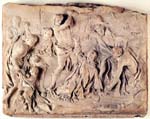 The Stoning of Peter 
Rabbi Dr. Epstein, editor of the Soncino Talmud: 
Then took they [the Pharisees] up stones to cast at him: but Jesus hid himself, and went out of the temple, going through the midst of them, and so passed by. — John 8:59 

You can help in the battle for Truth, Justice, and the American Way! Fight the forces of censorship and suppression of the Talmud, and bring about understanding between peoples of different faiths. 
Rabbi Yitzchok Adlerstein is the director of Project Next Step of the Simon Wiesenthal Center in Los Angeles and a professor of Jewish Law and Ethics at Loyola Law School. Rabbi Adlerstein calls the Talmud, "the world's oldest continuously-practiced legal code." Of Lewin's capital punishment brief, Rabbi Adlerstein states: 
"US President George W. Bush sent greetings and applauded the institute for promoting an 'understanding of Judaism's rich tradition of legal thought. As we face new challenges and welcome new opportunities, our society must continue to promote good character and strong values. Through the study and teaching of Jewish law and philosophy you are contributing to a growing culture of service, citizenship, and responsibility in America,' Bush wrote." — Jerusalem Post (1) |
This is the second in a 4-part series on the Death Penalty and Talmud Law. "Meticulous Application of Stringent Rules" —?The National Jewish COLPA/IAJLJ brief contains this statement that capital punishment in the Talmud was rare due to the Sages' concern for strict legal process: The infrequency of the death penalty was attributable to the meticulous application of stringent rules regarding the admissibility and sufficiency of evidence. A court of at least 23 judges would have to be satisfied, to a legal certainty, that the capital offense had been committed before the court could impose a death sentence. Since the testimony of two eye-witnesses was required, and the witnesses were subjected to searching and detailed interrogation by the court, there was rarely an instance when the evidence met the prescribed legal standard. — National Jewish COLPA/IAJLJ (13) We have already noted at least four incidents of stoning, or attempted stoning in the New Testament (Acts 7, John 8:7, John 8:59, and John 10:22-31. Stephen was taken before one priest — not 23. We are not told how many Pharisees were involved in the attempted stonings of Jesus of Nazareth, but certainly St. John's account gives the impression that the stoning was to proceed without formal trial before 23 judges with "meticulous application of stringent rules." (13) The Pharisees gave indication that they intended to stone Jesus on the spot (John 8:59). (Note: In upcoming Talmud excerpts, we sometimes omit non-germane text and footnotes. Omission of text is indicated by an ellipsis (…). To see the full text and footnotes, follow the hot link at the end of the excerpt. It is our pleasure to make available on line a number of Talmud tractates, so that you can see the excerpt in full context. We indicate unprintable Hebrew characters, words, and phrases with the symbol [H].) Level of ProofIn Kiddushim 80a the Sages indicate that they flagellate, stone, and burn on "strength of presumption." This is somewhat at odds with the representation in the National Jewish COLPA/IAJLJ brief, so let us go directly to the Talmud text. The word niddah means a woman is menstruating, or was menstruating within the previous seven days. Sexual intercourse is forbidden during this period of niddah. GEMARA. … For R. Hiyya b. Abba said in R. Johanan's name: We flagellate on the strength of presumption, we stone and burn on the strength if presumption, but we do not burn terumah on the strength of presumption. We flagellate on the strength of presumption, as Rab Judah. For Rab Judah said: If a woman is presumed a niddah by her neighbours, her husband is flagellated on her account as a niddah. (1) We stone and burn on the strength of presumption, as Rabbah son of R. Hunna. For Rabbah son of R. Huna said: If a man, woman, boy and girl lived (2) in a house [together], (3) they are stoned and burnt on each other's account. (4) R. Simeon b. Pazzi said in R. Joshua b. Levi's name on Bar Kappara's authority: It once happened that a woman came to Jerusalem carrying an infant on her back; she brought him up and he had intercourse with her, whereupon they were brought before Beth din and stoned. Not because he was definitely her son, but because he clung to her. — Babylonian Talmud, Tractate Kiddushim 80a Kiddushin translator Rabbi Dr. H. Freedman amplifies the text with this footnote:
— Rabbi Dr. Freedman In the historical cases cited above, there is every indication that those who were flagellated, stoned, and burned were Israelites. The index for Tractate Kiddushin does not contain an entry for "heathen" or "Noahide." There is only one entry for "Gentile," listing page 189, not page 411. Israelites, then, did not necessarily enjoy the "meticulous application of stringent rules" that Nathan Lewin, Rabbi Justice Elon, et al. say are the hallmarks of Talmudic justice. Recall the words of the National Jewish COLPA/IAJLJ brief: "Since the testimony of two eye-witnesses was required, and the witnesses were subjected to searching and detailed interrogation by the court, there was rarely an instance when the evidence met the prescribed legal standard." (13) Instead, the words of no less than five sages attest that the death penalty was meted out on the strength of the presumption that a) a crime was committed, and b) that the accused was guilty. 1,839 Missing JudgesNathan Lewin, Elon, et al. state in their brief that, "A court of at least 23 judges would have to be satisfied, to a legal certainty, that the capital offense had been committed before the court could impose a death sentence." (13) According to the following Mishnah, one rabbi tried, condemned, and executed 80 women on the same day. What happened to the 23 judges who would have to be satisfied to legal certainty in each case? MISHNAH. … WHEREUPON R. ELEIZER SAID TO THEM: BUT DID NOT SIMEON B. SHETAH HANG WOMEN AT ASHKELON? THEY RETORTED: [ON THAT OCCASION] HE HANGED EIGHTY WOMEN, NOTWITHSTANDING THAT TWO [MALEFACTORS] MUST NOT BE TRIED ON THE SAME DAY. — Babylonian Talmud, Tractate Sanhedrin 45b The translator adds in a footnote:
— Jacob Shachter (7) "Actually illegal," comments Rabbi Shachter, but the Talmud Sages noted the illegality only in the number of trials in that one day. None of the Sages mention the lack of 23 judges for each of the 80 women, and the impossibility of trying so many women according to proper procedure on a single day. Recall that proper procedure requires two witnesses for each of the accused, each of whom had "seen the perpetrator about to commit the crime and warned [the accused] of the potential penalty," each witness "subjected to searching and detailed interrogation by the court," and so forth. (5) We have already seen that a priest who performed ritual while unclean got no formal trial; he was simply taken out of the temple and clubbed to death (see Sentence and Execution). And we have learned about the trial of the sotah; that trial did not rely upon a panel of 23 judges either. Now we will learn about another class of exceptions: — Three Strikes and You're OutMISHNAH. HE WHO WAS TWICE FLAGELLATED [FOR TWO TRANSGRESSIONS, AND THEN SINNED AGAIN,] IS PLACED BY BETH DIN IN A CELL AND FED WITH BARLEY BREAD, UNTIL HIS STOMACH BURSTS. — Babylonian Talmud, Tractate Sanhedrin 81b Beth din is a Jewish court (Soncino Talmud Glossary). GEMARA. Because he has been twice flagellated Beth din places him in a cell? — R. Jeremiah answered in the name of Resh Lakish: The reference is to flagellation for an offence punishable by extinction, so that he is already liable to death [at the hand of God], but the time of his death has not yet come: since, however, he abandoned himself [to sin, by transgressing a third time], we hasten his death. — Babylonian Talmud, Tractate Sanhedrin 81b The above Mishnah and Gemara are somewhat ambivalent: The twice-flagellated person has committed an offense punishable by extinction, yet is apparently liable to death only at the hand of God, not man. He still lives, and sins a third time. The Sage says "we hasten his death" by causing his stomach to burst. However, this Gemara confirms what we suspect: GEMARA. … But we learnt, ONE WHO WAS TWICE FLAGELLATED IS PLACED BY BETH DIN IN A CELL: thus, the Merciful One exempted him, yet we slay him! — Babylonian Talmud, Tractate Sanhedrin 82b The following completes a picture for us: GEMARA. … AND FED 'BREAD OF ADVERSITY AND WATER OF AFFLICTION'. Why does this Mishnah teach, AND FED WITH BREAD OF ADVERSITY AND WATER OF AFFLICTION', whilst the former teaches, HE IS PLACED BY BETH DIN IN A CELL AND FED WITH BARLEY BREAD UNTIL HIS STOMACH BURSTS? — Babylonian Talmud, Tractate Sanhedrin 81b This passage provides an explanation of how this execution method works: GEMARA. … R. Shesheth answered: In both cases he is fed with 'bread of adversity and water of affliction' for his intestines to shrink [thus blocking the passage], and then he is fed with barley bread until his stomach bursts. — Babylonian Talmud, Tractate Sanhedrin 81b — Cases With Disjoined WitnessesTractate Sanhedrin 81b contains the following Mishnah: MISHNAH. ONE WHO COMMITS MURDER WITHOUT WITNESSES IS PLACED IN A CELL AND [FORCIBLY] FED WITH BREAD OF ADVERSITY AND WATER OF AFFLICTION'. — Babylonian Talmud, Tractate Sanhedrin 81b After this treatment the condemned is fed barley bread until his stomach bursts and he dies, as in Three Strikes and You're Out, above. GEMARA. How do we know [that he committed murder]? — Rab said: On a 'disjoined' evidence. (6) — Babylonian Talmud, Tractate Sanhedrin, 81b Talmudic scholar Rabbi Dr. H. Freedman, who translated this section of the Soncino Tractate Sanhedrin, explains the significance of "disjoined" evidence in a footnote:
— Rabbi Dr. Freedman (8) Two Tracks for JusticeFrom the above, we can see a two-tier system of capital punishment under Talmudic law: Formal capital punishment that is meted out after a formal trial when two non-disjoined witnesses give evidence and the accused is convicted; and informal capital punishment where there is no formal trial and the accused, on presumption or otherwise, is executed in prison. A system of lynchings and unofficial jailhouse executions would, of course, greatly reduce the number of official executions. Rabbi Dr. H. Freedman and Jacob Shachter, translators of the Soncino Tractate Sanhedrin, confirm this. In their Introduction, they comment on Sanhedrin Chapter IX: CHAPTER IX continues with the four modes of execution, and burning is stated to be the penalty of certain forms of incest. Those who are decapitated follow, viz., a murderer and the inhabitants of a condemned city. Noteworthy are the statements that a person who was twice flagellated and a murderer whose guilt, though adequately proved, was not attested with all the minutiae of the law, were irregularly put to death. This leads to the enumeration of other offences likewise punished irregularly. The Aggada deals at some length with the sinning of Israel at Baal Peor and Phineas's revenge. — Rabbi Dr. Freedman and Jacob Shachter (11), emphasis added Once again, it is as though Elon, Lewin, the National Jewish COLPA, IAJLJ, and the National Institute for Judaic Law do not expect anyone to read the Talmud. No one familiar with Tractate Sanhedrin could miss these "irregular" modes of capital punishment and the numerous methods for executing a death sentence without "meticulous application of stringent rules regarding the admissibility and sufficiency of evidence." — No Numbing of PainThe National Institute for Judaic Law brief does not mention this passage, but it is relevant: GEMARA. … When one is led out to execution, he is given a goblet of wine containing a grain of frankincense, in order to benumb his senses, for it is written, Give strong drink unto him that is ready to perish, and wine unto the bitter in soul. And it has also been taught; The noble women in Jerusalem used to donate and bring it. If these did not donate it, who provided it? As for that, it is certainly logical that it should be provided out of the public [funds]: Since it is written. 'Give', [the implication is] of what is theirs. — Babylonian Talmud, Tractate Sanhedrin 43a Frankincense does not have a medically recognized analgesic effect, and it has never been used in serious medical practice for that purpose. Obviously the grain of frankincense and goblet of wine was not effective in those ancient days, either: the following Mishnah states that the "wick" (i.e., molten lead) was thrown into the condemned man's mouth against his wishes, clearly indicating the condemned was conscious and struggling. MISHNAH. … HIS MONTH WAS FORCED OPEN WITH PINCERS AGAINST HIS WISH, THE WICK LIT AND THROWN INTO HIS MOUTH, SO THAT IT DESCENDED INTO HIS BODY AND BURNT HIS BOWELS … — Babylonian Talmud, Tractate Sanhedrin 52a Death With DignityJewish Law was particularly insistent on the preservation of even a criminal's rights and dignity during the course of punishment. Maimonides, after dealing with the types of punishment a court may impose, including imprisonment, concludes: "All these matters apply to the extent that the judge deems appropriate and necessary for the needs of the time. In all matters, he shall act for the sake of Heaven and not regard human dignity lightly … He must be careful not to destroy their dignity." According to Jewish law, a death sentence must be carried out with the minimum of suffering and without offense to human dignity. This is based on the Biblical verse, "Love your fellow as yourself," and the rule is, "Choose for him a humane death." From this we declare that even a condemned felon is your "fellow." — National Jewish COLPA and IAJLJ (4) (ellipsis is in text of brief) Remember, the parties who submitted the brief — the National Jewish Commission on Law and Public Affairs and the American Section of the International Association of Jewish Lawyers and Jurists — have stated that they wish Jewish principles concerning capital punishment to be used as a guide in our American situation. National Jewish COLPA and IAJLJ are vitally interested in promoting the study of, and respect for, principles of Jewish Law as they have been applied throughout the history of the Jewish people. National Jewish COLPA and the national groups that it routinely represents promote and encourage in-depth study of Talmudic texts. IAJLJ has sponsored public lectures in Jewish Law and promoted the publication of scholarly essays in the field of Jewish Law. — National Jewish COLPA and IAJLJ (9) (emphasis added) As you read the following, consider how death with dignity might be achieved. — Stripped NakedMISHNAH. WHEN HE IS ABOUT FOUR CUBITS DISTANT FROM THE PLACE OF STONING, HE IS STRIPPED OF HIS GARMENTS. A MAN IS COVERED IN FRONT AND A WOMAN BOTH IN FRONT AND BEHIND: THIS IS R. JUDAH'S VIEW. BUT THE SAGES SAY: A MAN IS TO BE STONED NAKED BUT A WOMAN IS NOT TO BE STONED NAKED. — Babylonian Talmud, Tractate Sanhedrin 44b To the modern mind, public nakedness would not contribute to death with dignity. — Buried In ManureIn both of burning and strangulation, the condemned are "buried up to their armpits" in manure. MISHNAH. THE MANNER IN WHICH BURNING IS EXECUTED IS AS FOLLOWS: HE WHO HAD BEEN THUS CONDEMNED WAS LOWERED INTO DUNG UP TO HIS ARMPITS THEN A HARD CLOTH WAS PLACED WITHIN A SOFT ONE, WOUND ROUND HIS NECK, AND THE TWO LOOSE ENDS PULLED IN OPPOSITE DIRECTIONS, FORCING HIM TO OPEN HIS MOUTH. — Babylonian Talmud, Tractate Sanhedrin 52a MISHNAH. STRANGULATION WAS THUS PERFORMED: — THE CONDEMNED MAN WAS LOWERED INTO DUNG UP TO HIS ARMPITS, THEN A HARD CLOTH WAS PLACED WITHIN A SOFT ONE, WOUND ROUND HIS NECK, AND THE TWO ENDS PULLED IN OPPOSITE DIRECTIONS UNTIL HE WAS DEAD. — Babylonian Talmud, Tractate Sanhedrin 52b Again, to the modern mind, it is difficult to understand how burial in a pit of dung could be either dignifying or humane. — Women Stripped to the Waist And Publicly DisplayedWe have already learned about the woman subjected to trial by ordeal (the sotah) at the request of her suspicious husband. When she arrives at the temple for the trial, the priests ask her if she has been unfaithful; if she says yes, she is divorced. However, if she asserts her innocence, she is forcibly stripped to the waist and put on public display, as follows: MISHNAH. … IF SHE SAYS, 'I AM PURE', THEY BRING HER UP TO THE EAST GATE WHICH IS BY THE ENTRANCE OF NICANOR'S GATE WHERE THEY GIVE SUSPECTED WOMEN WATER TO DRINK, PURIFY WOMEN AFTER CHILDBIRTH, AND PURIFY LEPERS. A PRIEST SEIZES HER GARMENTS — IF THEY ARE RENT THEY ARE RENT, AND IF THEY BECOME UNSTITCHED THEY ARE UNSTITCHED UNTIL HE UNCOVERS HER BOSOM, AND HE UNDOES HER HAIR. R. JUDAH SAYS: IF HER BOSOM WAS BEAUTIFUL HE DOES NOT UNCOVER IT, AND IF HER HAIR WAS BEAUTIFUL HE DOES NOT UNDO IT. — IF SHE WAS CLOTHED IN WHITE, HE CLOTHES HER IN BLACK. IF SHE WORE GOLDEN ORNAMENTS AND NECKLACES, EAR-RINGS AND FINGER-RINGS, THEY REMOVE THEM FROM HER IN ORDER TO MAKE HER REPULSIVE. AFTER THAT [THE PRIEST] TAKES A COMMON ROPE AND BINDS IT OVER HER BREASTS. WHOEVER WISHES TO LOOK UPON HER COMES TO LOOK WITH THE EXCEPTION OF HER MALE AND FEMALE SLAVES, BECAUSE HER HEART IS MADE DEFIANT THROUGH THEM. ALL WOMEN ARE PERMITTED TO LOOK UPON HER, AS IT IS SAID, THAT ALL WOMEN MAY BE TAUGHT NOT TO DO AFTER YOUR LEWDNESS. — Babylonian Talmud, Tractate Sotah 7a-b Notice that the woman is presumed to be guilty, even though she denies it. Her husband has no proof that she has committed adultery, and the outcome of her trial by ordeal is not yet known. Still, she is held up as an example "that all women may be taught not to do after your lewdness." In American society, even in ordinary circumstances, most of use would find it difficult to maintain our dignity when we are naked while those around us are clothed. Most of us would find it difficult to maintain dignity when buried up to our armpits in animal manure. Most women would find it difficult to maintain dignity when stripped to the waist and put on pubic display, especially when there is no evidence they have committed a crime. If we find it difficult to maintain dignity in these situations generally, how much more sensitive might we be during the process of execution? We might even jump to the conclusion we were being purposely humiliated and degraded on the way to our death. — Corpse Hanged Naked After DeathAs mentioned above, the condemned is stripped naked for before stoning (Tractate Sanhedrin 44b). Following the stoning, the corpse is hanged on public display (Tractate Sanhedrin 44b, Tractate Sanhedrin 46a). No mention is made of re-clothing the corpse between these two procedures. To some, hanged naked and bloody in public after death would be the ultimate indignity, and no one would consider it an honor. Scope of Capital Punishment ApplicationRecall that Rabbi Elon and advocate Lewin assert that capital punishment was infrequently used by the rabbinic Sages of the Talmud. Browsing through the Tractate Sanhedrin, however, we discover that capital is used on a wide array of infractions. — To Discipline TeenagersAt parental request, capital punishment is used to discipline pubescent male children (ellipsis […] indicates non-germane text omitted): MISHNAH. THE FOLLOWING ARE STONED: … A WAYWARD AND REBELLIOUS SON. — Babylonian Talmud, Tractate Sanhedrin 53a MISHNAH. 'A STUBBORN AND REBELLIOUS SON': WHEN DOES HE BECOME LIABLE TO THE PENALTY OF A STUBBORN AND REBELLIOUS SON'? FROM THE TIME THAT HE PRODUCES TWO HAIRS UNTIL HE GROWS A BEARD RIGHT ROUND (BY WHICH IS MEANT THE HAIR OF THE GENITALS, NOT THAT OF THE FACE, BUT THAT THE SAGES SPOKE IN POLITE TERMS), FOR IT IS WRITTEN, IF A MAN HAVE A STUBBORN AND REBELLIOUS SON: 'A SON', BUT NOT A DAUGHTER; 'A SON', BUT NOT A FULL-GROWN MAN. WHILST A MINOR IS EXEMPT, SINCE HE DOES NOT COME WITHIN THE SCOPE OF THE COMMANDMENTS. — Babylonian Talmud, Tractate Sanhedrin, 68b See also Sanhedrin 71b and 72a for further information. — To Encourage Doctrinal ConformityMISHNAH. 'A FALSE PROPHET'; HE WHO PROPHESIES WHAT HE HAS NOT HEARD, OR WHAT WAS NOT TOLD TO HIM, IS EXECUTED BY MAN. — Babylonian Talmud, Tractate Sanhedrin 89a MISHNAH. 'AN ELDER REBELLING AGAINST THE RULING OF BETH DIN' [IS STRANGLED] … — Babylonian Talmud, Tractate Sanhedrin 86b — To Teach A Civic LessonThe news of the upcoming execution of an unorthodox elder is broadly promoted to instill fear in the pubic and to discourage others from acting "presumptuously." MISHNAH. HE [THE REBELLIOUS ELDER] WAS EXECUTED NEITHER BY HIS LOCAL BETH DIN NOR BY THE BETH DIN AT JABNEH, BUT WAS TAKEN TO THE GREAT BETH DIN IN JERUSALEM AND KEPT THERE UNTIL THE [NEXT] FESTIVAL AND EXECUTED THEREON, FOR IT IS WRITTEN, 'AND ALL THE PEOPLE SHALL HEAR AND FEAR, AND DO NO MORE PRESUMPTUOUSLY:' THIS IS R. AKIBA'S OPINION. R. JUDAH SAID: HIS JUDGMENT MUST NOT BE DELAYED, BUT HE IS EXECUTED IMMEDIATELY, WHILST PROCLAMATIONS ARE INDITED AND SENT BY MESSENGERS TO ALL PLACES, 'SO AND SO HAS BEEN SENTENCED TO DEATH AT BETH DIN.' — Babylonian Talmud, Tractate Sanhedrin 89a — To Punish Improper RitualWe have already discussed the punishment of a priest who performs ritual while unclean; he is clubbed to death by his colleagues (see Sentence and Execution). — For Bearing False WitnessGEMARA. … Again Raba said: [If witnesses testify] that so and so committed adultery with a betrothed woman and their evidence is refuted, they are liable to capital punishment … — Babylonian Talmud, Tractate Sanhedrin 10a GEMARA. … Raba said further: [If witnesses testify] that so and so committed an unnatural crime with an ox, and the evidence is afterwards refuted, they are liable to capital punishment, but not to be mulcted in respect of the ox. — Babylonian Talmud, Tractate Sanhedrin 10a — For Forbidden SexHomosexuality: This Mishnah states that sex between two males is punishable by death. (Homosexuality between a man and a boy under nine was not punishable; see Sex with Children by Talmud Rules. Homosexuality between children was not punishable; see below.) MISHNAH. HE WHO COMMITS SODOMY WITH A MALE OR A BEAST, AND A WOMAN THAT COMMITS BESTIALITY ARE STONED. IF THE MAN HAS SINNED, WHEREIN HAS THE ANIMAL OFFENDED? BUT BECAUSE MAN WAS ENTICED TO SIN THEREBY, SCRIPTURE ORDERED THAT IT SHOULD BE STONED. ANOTHER REASON IS THAT THE ANIMAL SHOULD NOT PASS THROUGH THE STREETS, WHILST PEOPLE SAY, THIS IS THE ANIMAL ON ACCOUNT OF WHICH SO AND SO WAS STONED. — Babylonian Talmud, Tractate Sanhedrin 54a However, Jewish and non-Jewish male children may have sex with each other, provided the Jewish child does not become accustomed to it. GEMARA. They decreed in connection with a heathen child that it should cause defilement by seminal emission so that an Israelite child should not become accustomed to commit pederasty with him. — Babylonian Talmud, Tractate Abodah Zarah 36b — For Sex With Other Jews' Wives and FiancéesGEMARA. … "He who commits adultery with a married woman is executed by strangulation …" — King David, as quoted in Babylonian Talmud, Tractate Sanhedrin 107a [Ellipsis indicates omitted text.] MISHNAH. THE FOLLOWING ARE STONED: … HE WHO COMMITS ADULTERY WITH A BETROTHED MAIDEN … — Babylonian Talmud, Tractate Sanhedrin 53a MISHNAH. THE FOLLOWING ARE STRANGLED … ONE WHO COMMITS ADULTERY … — Babylonian Talmud, Tractate Sanhedrin 84b However, adultery with the wife of a minor or a non-Jew is permitted. GEMARA. Our Rabbis taught: [And the man that committeth adultery with another man's wife, even he that committeth adultery with his neighbour's wife the adulterer and the adulteress shall surely be put to death]. 'The man' excludes a minor; 'that committeth adultery with another man's wife' excludes the wife of a minor; 'even he that committeth adultery with his neighbour's wife' excludes the wife of a heathen … — Babylonian Talmud, Tractate Sanhedrin 52b — For Betrothed Women Who "Play The Harlot"As we have already seen, if a betrothed maiden "plays the harlot," she is executed. GEMARA. … Shila taught: There are three modes [of execution] in the case of a [betrothed] damsel [who played the harlot]. — Babylonian Talmud, Tractate Kethuboth, 44b For more information on the capital offense laws pertaining to consensual sex acts, it is recommended that the reader use the Come and Hear™ Search Engine, searching on words such as virgin, wife, maiden, harlot, woman, adultery, etc. — For BestialityMISHNAH. … CAPITAL CASES ARE ADJUDICATED BY TWENTY-THREE. THE PERSON OR BEAST CHARGED WITH UNNATURAL INTERCOURSE, BY TWENTY-THREE, AS IT IS WRITTEN, THOU SHALT KILL THE WOMAN AND THE BEAST, AND ALSO, YE SHALL SLAY THE BEAST. — Babylonian Talmud, Tractate Sanhedrin 2a MISHNAH. HE WHO COMMITS SODOMY WITH A MALE OR A BEAST, AND A WOMAN THAT COMMITS BESTIALITY ARE STONED. — Babylonian Talmud, Tractate Sanhedrin 54a Note: Special allowances may have been made "when a Jew committed bestiality in ignorance." See discussion in Gemara of Tractate Sanhedrin 55a and 55b, and Dr. Freedman's commentary in footnotes. Dr. Freedman comments: "When bestiality is committed in ignorance, one has not sinned, yet he has greatly degraded himself." — For Religious Infractions— — Sorcery[Ellipsis indicates omitted text.] MISHNAH. THE FOLLOWING ARE STONED … A SORCERER … — Babylonian Talmud, Tractate Sanhedrin 53a — Uttering God's Name / BlasphemyMISHNAH. THE BLASPHEMER IS PUNISHED ONLY IF HE UTTERS [THE DIVINE] NAME. — Babylonian Talmud, Tractate Sanhedrin 55b MISHNAH. THE FOLLOWING ARE STONED … A BLASPHEMER … — Babylonian Talmud, Tractate Sanhedrin 53a — Desecrating The SabbathMISHNAH. THE FOLLOWING ARE STONED: … HE WHO DESECRATES THE SABBATH … — Babylonian Talmud, Tractate Sanhedrin 53a — IdolatryMISHNAH. THE FOLLOWING ARE STONED … AN IDOLATER … HE WHO INCITES [INDIVIDUALS TO IDOLATRY] … — Babylonian Talmud, Tractate Sanhedrin 53a Mass Capital Punishment— On Unwanted CitizensLet us revisit the Mishnah describing the hanging of eighty women on the same day (discussed above): MISHNAH. … THE SAGES SAY: A MAN IS HANGED, BUT NOT A WOMAN. WHEREUPON R. ELIEZER SAID TO THEM: BUT DID NOT SIMEON B. SHETAH HANG WOMEN AT ASHKELON? THEY RETORTED: [ON THAT OCCASION] HE HANGED EIGHTY WOMEN, NOTWITHSTANDING THAT TWO [MALEFACTORS] MUST NOT BE TRIED ON THE SAME DAY. — Babylonian Talmud, Tractate Sanhedrin 45b Indeed, it would require quite a capital punishment infrastructure to administer the execution of 80 women on one day in the same town. This example suggests that despite National Jewish COLPA/IAJLJ representations, capital punishment was readily used, and support structures for capital punishment were readily available and in use. — For Tribes, Towns, and Cities that StrayOn determination that the majority of people in a tribe, town, or city is moving away from Judaism to worship "other gods," Talmudic courts may exterminate the entire population — men, women, children, innocent and guilty alike, all are killed and the city is burned to the ground. A footnote cites Deuteronomy 13:14 as the authority. (Ellipsis indicates omitted text.) MISHNAH. … MULTITUDES ARE DECAPITATED; HENCE THEIR POSSESSIONS ARE DESTROYED … THOU SHALT SURELY SMITE THE INHABITANTS OF THAT CITY WITH THE EDGE OF THE SWORD … DESTROYING IT UTTERLY, AND ALL THAT IS THEREIN … — Babylonian Talmud, Sanhedrin 111b This is not a trial of individuals, but the trial of the "tribe" (town, or city) as a single entity, with a single verdict and a single sentence for all. MISHNAH. … A TRIBE … CAN ONLY BE TRIED BY A COURT OF SEVENTY-ONE … NO CITY CAN BE DECLARED CONDEMNED SAVE BY A DECREE OF A COURT OF SEVENTY-ONE. A FRONTIER TOWN CANNOT BE CONDEMNED NOR THREE CITIES AT A TIME, BUT ONLY ONE OR TWO. — Babylonian Talmud, Tractate Sanhedrin 2a Even two such cities may be doomed to extermination in a single trial. That is the established law of the Talmud, as recorded in the Mishnah. Note: To be labeled an idolater, it is not necessary to worship idols. Those Jews who have refused to acknowledge the Talmud and its Oral Law and who have insisted on the primacy of the Written Law (the Old Testament) have been labeled "idolaters" by rabbinical Judaism. See Rabbi Michael L. Rodkinson's summary, in Critical Words of Talmud Study. Frequency Of Capital Punishment — Makkoth 7aAccording to the National Jewish COLPA/IAJLJ Supreme Court brief, executions under Jewish law were rare: Although the Biblical text appears to contemplate frequent imposition of capital punishment, the weight of authority among rabbis of the Mishnaic period (1st-3rd centuries of the Common Era), who first committed to writing what had theretofore been transmitted from generation to generation as the Oral Law, clearly condemned frequent executions. The Mishnah in the tractate Makkoth (7a) declared: — National Jewish COLPA/IAJLJ (13) Come and Hear™ believes that the National Jewish COLPA/IAJLJ legal team took Makkoth 7a out of context (see Abuse of Context); but let us put that thesis aside for a moment, and evaluate the claim against what we already know. Against Makkoth 7a we must balance other passages in the Talmud that indicate that capital punishment was frequently used. — Rabbinical Death RowThis passage seems to argue that the death penalty was used frequently. MISHNAH. … IF A NUMBER OF CONDEMNED PERSONS DIFFERING IN THEIR DEATH SENTENCES BECAME MIXED UP WITH ONE ANOTHER, THEY ARE EXECUTED BY THE MOST LENIENT [DEATH]. IF CRIMINALS CONDEMNED TO STONING [BECAME MIXED UP] WITH OTHERS CONDEMNED TO BURNING, — R. SIMEON SAID: THEY ARE STONED, BECAUSE BURNING IS SEVERER … IF MEN CONDEMNED TO DECAPITATION BECAME MIXED UP WITH OTHERS CONDEMNED TO STRANGLING, — R. SIMEON SAID: THEY ARE [ALL] DECAPITATED; THE SAGES SAY: THEY ARE STRANGLED. … — Babylonian Talmud, Tractate Sanhedrin 79b This indicates that the rabbis had their own Death Row, and that it was relatively crowded. There would be no practical reason to maintain all these condemned persons in their cells over a period of seven years, or even seventy years, executing one at a time. — Was Talmudic Law Practiced, Ignored, Or Imagined?The National Jewish COLPA/IAJLJ statement that the death penalty was used infrequently in the Talmudic justice system puts the student in a quandary. From Rabbi Dr. Hertz, we learn that there were two principal centers in which Talmudic law was developed: Babylon and Palestine. (15) While Rabbi Dr. Hertz does not give population statistics for the thousands of years in which Talmudic judges administered their own courts from early Talmudic days to present time, folios 16, 17, and 18 of the Sanhedrin bear witness to an active, living court system with tens of thousands of judges administering Talmudic justice to the citizens. GEMARA. … Our Rabbis taught: And place such over them to be rulers of thousands, rulers of hundreds, rulers of fifties and rulers of tens: (10) The rulers of thousands amounted to six hundred; (11) those of hundreds, six thousand; those of fifties, twelve thousand; and those of tens, sixty thousand. Hence the total number of judges in Israel was seventy-eight thousand and six hundred. — Babylonian Talmud, Tractate Sanhedrin, 18a Talmud scholar and translator Jacob Shachter amplifies the text with footnotes:
— Jacob Shachter According to this Gemara, the number of judges required for 600,000 people was 78,600. There was one judge for every 7.63 people, an extraordinarily high citizen-to-judge ratio. Consider the broad array of crimes for which capital punishment was prescribed. If we are to believe the statement that a Sanhedrin that effected an execution once in seven or seventy years was branded "destructive," we must believe that, in seven or seventy years, of all those 600,000 souls:
If that does not seem likely, we must consider a second option:
Recall that the Elon/Lewin brief calls the Talmudic law "the oldest and most venerable legal system known to man." (9) No legal system, especially "the oldest and most venerable known to man" becomes venerable through lack of application. Some argue that much in the Talmud is theoretical, a record of the Sages arguing, attempting to arrive at principles and fine points of law. They may wish to argue that much of what the Talmud says about capital punishment is theoretical in nature. It is true that some passages in the Talmud deal with theoretical issues. The following passages illustrate the point. In this passage, the Sages are attempting to determine liability in this case: A man falls from a roof and, as a result, accidentally inserts his penis in his sister-in law, who is, somehow, correctly positioned below him on the ground. GEMARA. … There can be no compulsion in sexual intercourse since erection depends entirely on the will! But when he slept? Surely Rab Judah ruled that one in sleep cannot acquire his sister-in-law! But when accidental insertion occurred? Surely Rabbah stated: One who fell from a roof and his fall resulted in accidental insertion, is liable to pay an indemnity, for four things, and if the woman was his sister-in-law no kinyan is thereby constituted! — It is when, for instance, his intention was intercourse with his wife and his sister-in-law seized him and he cohabited with her. — Babylonian Talmud, Tractate Yebamoth 53b - 54a Note the special use of the word "cohabited." (10) Here is another hypothetical discussion of legal theory concerning a union of mice who execute a cat. GEMARA. … A man borrowed a bucket from his neighbour, and it broke. When he came before R. Papa, he said to him, 'Go and bring witnesses that you did not put it to foreign use, and you will be free from liability.' — Babylonian Talmud, Tractate Baba Mezi'a 97a Compare those two theoretical discussions with the following: MISHNAH. … R. ELEAZAR B. ZADOK SAID: IT ONCE HAPPENED THAT A PRIEST'S DAUGHTER COMMITTED ADULTERY, WHEREUPON BUNDLES OF FAGGOTS WERE PLACED ROUND ABOUT HER AND SHE WAS BURNT. THE SAGES REPLIED, THAT WAS BECAUSE THE BETH DIN AT THAT TIME WAS NOT WELL LEARNED IN LAW. — Babylonian Talmud, Tractate Sanhedrin 52a This passage does not appear theoretical. It seems to describe a real case. And the preponderance of the passages on capital punishment reviewed in this essay have obviously described real cases, and described real law applied to those cases. The National Jewish COLPA/IAJLJ statement that execution was rare under Talmudic judges does pass the common sense test. Now let's evaluate Makkoth 7a in context.
Thank you for your consideration of the above,
NEXT: Death Penalty 3: Abuse of Context
Endnotes:
| ||||||||||||||||||||||||||||||||||||||||
Footnotes:
Full specifics for each of the printed sources are provided in the Bibliography. Outside URLs were valid at the time this article was written. However, be mindful that URLs do change.
- "Jewish law institute launched in DC," Jerusalem Post, November 9, 2002, http://www.jpost.com/servlet/Satellite?pagename=JPost/A/JPArticle/ShowFull&cid=1036830287246, now moved to http://pqasb.pqarchiver.com/jpost/index.html?ts=1042784008, cached at: http://www.come-and-hear.com/editor/cp-jp-11-09-2002
- Stoning of St. Stephen, unknown artist, Rome, 18th century oil on canvas
- "Rabbi Noson and Rebbetzin Miriam Gurary," Chabad of Buffalo, http://www.chabadofbuffalo.com/RNG.htm cached at html://www.come-and-hear.com/editor/cp-gurary2.
- "Argument II," Brief: http://www.jlaw.com/Briefs/capital2.html cached at: http://www.come-and-hear.com/editor/cp-brief-argument
- Rabbi Yitzchok Adlerstein, director of the Jewish Studies Institute of Yeshiva of Los Angeles and chair of Jewish Law and Ethics at Loyola Law School: http://www.jewishjournal.com/old/deathpenalty2.3.10.0.htm cached at http://www.come-and-hear.com/editor/cp-adlerstein
- McGill Reporter, October 10, 2002, Volume 35 Number 03, http://www.mcgill.ca/reporter/03/elon/ http://www.come-and-hear.com/editor/cp-mcgill
- Babylonian Talmud, Tractate Sanhedrin 45b, page 300, note 2, available in Come and Hear™ hypertext as Sanhedrin 45b, note 44, http://www.come-and-hear.com/sanhedrin/sanhedrin_45.html#45b_44
- Babylonian Talmud, Tractate Sanhedrin 81b, page 541, note 6, available in Come and Hear™ hypertext as Sanhedrin 81b, note 19, http://www.come-and-hear.com/sanhedrin/sanhedrin_81.html#81b_19
- Brief of the National Jewish Commission on Law Public Affairs, et al. (hereinafter, Brief), "Interest of the Amici Curiae": http://www.jlaw.com/Briefs/capital1.html cached at: http://www.come-and-hear.com/editor/cp-brief-amicus
- By context, here and elsewhere, it is evident that the Soncino translators have adopted "cohabit" as a euphemism for sexual intercourse. In normal English, cohabit means only "To live together in a sexual relationship, especially when not legally married; To coexist, as animals of different species." (The American Heritage Dictionary of the English Language, Fourth Edition).
- Babylonian Talmud, "Introduction," Tractate Sanhedrin, Vol. III, page xv, available in Come and Hear™ hypertext http://www.come-and-hear.com/sanhedrin/index.html#intro
- Babylonian Talmud, "Introduction," Seder Nezikin, Vol. I, page xxxiii, available in Come and Hear™ hypertext http://www.come-and-hear.com/talmud/nezikin.html#xxxiii
- "Argument," Introduction, Brief: http://www.jlaw.com/Briefs/capital2.html cached at: http://www.come-and-hear.com/editor/cp-brief-argument
- "Jewish Law and the Supreme Court: Happy Millennium From an Ancient Legal Tradition," Project Next Step by Rabbi Yitzchok Adlerstein, http://projectnextstep.org/adlerstein-articles/jewish-law-supreme-court.htm cached at http://www.come-and-hear.com/editor/cp-adlerstein2
- Babylonian Talmud, "Foreword," Seder Nezikin, Vol. I, page xiv, available in Come and Hear™ hypertext at http://www.come-and-hear.com/talmud/nezikin_h.html
- The Talmud studies "Sentence and Execution," "Accusation and Trial," "Abuse of Context," and "US v. Talmud Law" are found at http://www.come-and-hear.com/editor/capunish_1.html, http://www.come-and-hear.com/editor/capunish_2.html, http://www.come-and-hear.com/editor/capunish_3.html, and http://www.come-and-hear.com/editor/capunish_4.html, respectively.
Appendix
Here is the opening Mishnah from Tractate Kerithoth. The numbers and line breaks are added here for ease of readership — the line breaks are not in the Soncino Talmud. Technical terms are linked to the Glossary.
MISHNAH. THERE ARE IN THE TORAH THIRTY-SIX [TRANSGRESSIONS WHICH ARE PUNISHABLE WITH] EXTINCTION:
- WHEN ONE HAS INTERCOURSE WITH HIS MOTHER,
HIS FATHER'S WIFE OR HIS DAUGHTER-IN-LAW; - WHEN A MAN HAS CONNECTION WITH A MALE,
OR COVERS A BEAST, OR WHEN A WOMAN ALLOWS HERSELF TO BE COVERED BY A BEAST; - WHEN ONE HAS INTERCOURSE WITH A WOMAN AND HER DAUGHTER,
WITH A MARRIED WOMAN, WITH HIS SISTER, WITH HIS FATHER'S SISTER, HIS MOTHER'S SISTER, HIS WIFE'S SISTER, HIS BROTHER'S WIFE, THE WIFE OF HIS FATHER'S BROTHER, OR WITH A MENSTRUOUS WOMAN; - WHEN ONE BLASPHEMES [THE LORD],
SERVES IDOLS, DEDICATES OF HIS CHILDREN TO MOLECH OR HAS A FAMILIAR SPIRIT, OR DESECRATES THE SABBATH; - WHEN AN UNCLEAN PERSON EATS OF SACRIFICIAL FOOD,
OR WHEN ONE ENTERS THE PRECINCTS OF THE TEMPLE IN AN UNCLEAN STATE; - WHEN ONE EATS HELEB,
BLOOD, NOTHAR OR PIGGUL; - WHEN ONE SLAUGHTERS
OR OFFERS UP [A CONSECRATED ANIMAL] OUTSIDE [THE TEMPLE PRECINCTS]; - WHEN ONE EATS ANYTHING LEAVENED ON PASSOVER;
- WHEN ONE EATS
OR WORKS ON THE DAY OF ATONEMENT; - WHEN ONE COMPOUNDS OIL [OF ANOINTING]
OR COMPOUNDS INCENSE, OR USES [UNLAWFULLY] OIL OF ANOINTING; - AND [WHEN ONE TRANSGRESSES THE LAWS OF] THE PASCHAL OFFERING,
AND CIRCUMCISION.
— FROM AMONG POSITIVE COMMANDMENTS. FOR THESE [TRANSGRESSIONS] ONE IS LIABLE TO EXTINCTION IF COMMITTED WILFULLY, AND IF IN ERROR TO A SIN-OFFERING, AND IF THERE IS A DOUBT WHETHER HE HAD COMMITTED THE TRANSGRESSION TO A SUSPENSIVE GUILT-OFFERING, EXCEPT IN THE CASE OF ONE WHO DEFILED THE TEMPLE OR ITS CONSECRATED THINGS, SINCE ONE IS LIABLE IN THIS CASE TO A SLIDING-SCALE SACRIFICE. THUS R. MEIR, WHILE THE SAGES SAY: ALSO THE BLASPHEMER [IS AN EXCEPTION], FOR IT SAYS: YE SHALL HAVE ONE LAW FOR HIM THAT DOETH AUGHT IN ERROR; THIS IS TO EXCLUDE THE BLASPHEMER WHO PERFORMS NO ACTION.— Babylonian Talmud, Tractate Kerithoth 2b
© Copyright Carol A. Valentine, 2003. See copyright statement at http://www.come-and-hear.com/copyright.html
NEXT: Death Penalty 3: Abuse of Context
Navigate This Site Home Valentine Dilling Talmud The Rabbis Supplement Glossary Download Admin

 Genuine Come and Hear™ CDs do not contain executable programs. When making CDs, do not include any files that end in .exe, .com, .bat, .vbs, .doc, .pif, .sit, or .scr. The person receiving the CD should use his own browser to view the files. This helps to protect him from harmful programs and viruses.
Genuine Come and Hear™ CDs do not contain executable programs. When making CDs, do not include any files that end in .exe, .com, .bat, .vbs, .doc, .pif, .sit, or .scr. The person receiving the CD should use his own browser to view the files. This helps to protect him from harmful programs and viruses. 



